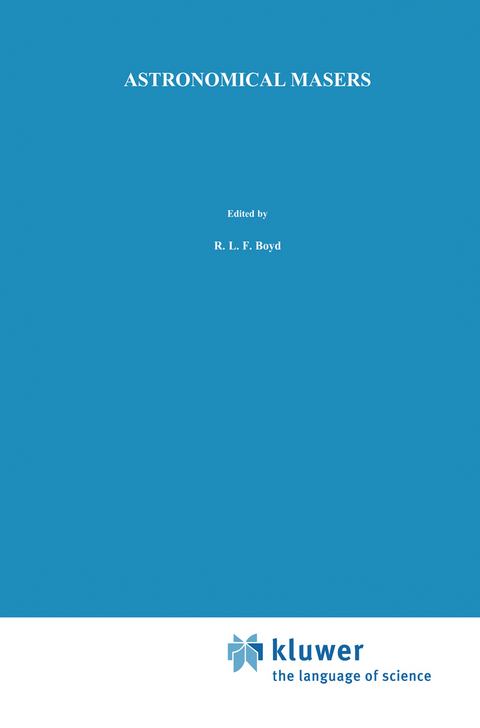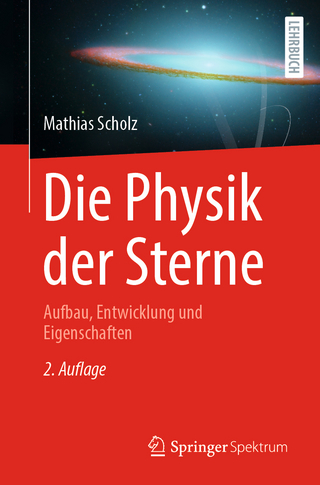
Astronomical Masers
Springer (Verlag)
978-0-7923-1217-8 (ISBN)
This book provides an extensive coverage of the interstellar maser phenomenon.
One of the most spectacular discoveries of molecular astronomy has been the detection of maser emission. The same radiation that is generated in the laboratory only with elaborate, special equipment occurs naturally in interstellar space. This intense radiation probes the smallest structures that can be studied with radio telescopes. By a fortunate coincidence maser radiation is generated in both star forming regions and the envelopes of late-type stars. The early and late stages in the life of a star are considered to be the most interesting phases of stellar evolution. Maser emission has also been detected in external galaxies.
This book provides an extensive coverage of the interstellar maser phenomenon. A precondition for maser action is departure from thermal equilibrium. The book therefore starts with a detailed coverage of the basic background concepts required for an understanding of line formation and radiative transfer. It goes on to describe the theoretical and phenomenological aspects of interstellar masers, their formation sites and the inversion mechanisms.
The book will interest active researchers in astronomy and astrophysics as well as in other areas of physics. It is suitable as a textbook in a graduate course and will enable a graduate student to embark on research projects in this exciting area in particular, and molecular radio astronomy in general.
1: Introduction.- 2: Basic Background Concepts.- 2.1. Thermodynamic Equilibrium and Detailed Balance.- 2.2. Thermal Motions and Collisions.- 2.3. Radiation — Generalities.- 2.4. Interaction Between Matter and Line Radiation.- 2.5. The Two-Level Model.- 2.6. The Escape Probability Method.- 2.7. The Level Population Equations.- 3: Astronomical Maser Radiation.- 3.1. The Maser Molecules.- 3.2. Evidence for Maser Action.- 3.3. Characteristics of the Radiation.- 4: Maser Theory.- 4.1. Formal Background †.- 4.2. Phenomenological Maser Theory.- 4.3. The Linear Maser.- 4.4. Background Radiation (I).- 4.5. Maser Linewidths.- 5: Effects of Geometry.- 5.1. Beaming.- 5.2. General Properties of Saturated Masers.- 5.3. Maser Escape Probability †.- 5.4. Spherical Masers.- 5.5. Filamentary Masers.- 5.6. Comparison of Different Geometries.- 5.7. Background Radiation (II).- 6: Polarization.- 6.1. Generalities.- 6.2. Stokes Parameters.- 6.3. Polarization in a Magnetic Field.- 6.4. Level Populations and Radiative Transfer.- 6.5. Fully Resolved Zeeman Pattern: g?B » ?.- 6.6. Overlapping Zeeman Components: g?B « ?.- 6.7. Polarization Filters.- 6.8. Faraday Rotation †.- 6.9. Comparison with Observations.- 7: Pumping.- 7.1. General Considerations.- 7.2. Radiative Pumps.- 7.3. Collisional Pumps.- 7.4. Chemical Pumps.- 7.5. Geometric Considerations.- 8: The Environments of Astronomical Masers.- 8.1. Interstellar Clouds.- 8.2. Maser Chemistry.- 8.3. Star-Forming Regions; H ii Regions.- 8.4. Late-Type Stars.- 8.5. The Geometry of Astronomical Masers.- 8.6. Saturation in Astronomical Masers.- 9: OH Masers.- 9.1. Satellite-Line Inversions.- 9.2. OH Masers in Late-Type Stars.- 9.3. H ii/OH Regions.- 9.4. Excited OH.- 9.5. Polarization.- 9.6. Comets.- 10: H2O Masers.- 10.1. BasicInversion — the Backbone.- 10.2. H2O Masers in Late-Type Stars.- 10.3. H2O Masers in Star-Forming Regions.- 10.4. Submillimeter H2O Masers.- 11: SiO Masers.- 11.1. Basic Inversion Considerations.- 11.2. SiO Masers in Late-Type Stars.- 11.3. Pumping Mechanisms.- 11.4. The Orion SiO Maser.- 12: Other Masers.- 12.1. Methanol (CH3OH).- 12.2. Ammonia (NH3).- 13: Extragalactic Masers.- 13.1. OH.- 13.2. H2O.- 14: Masers as Astronomical Tools.- 14.1. Distance Measurements.- 14.2. Galactic Properties.- 14.3. Interstellar Scattering.- 14.4. Circumstellar Disk Structure.- 14.5. Evolutionary Schemes for Late-Type Stars.- 15: Epilogue.- Appendix A: Beaming in Filamentary Masers †.- Appendix: Maser Properties in Different Geometries.- References.
| Reihe/Serie | Astrophysics and Space Science Library ; 170 |
|---|---|
| Zusatzinfo | XIV, 351 p. |
| Verlagsort | Dordrecht |
| Sprache | englisch |
| Maße | 155 x 235 mm |
| Themenwelt | Naturwissenschaften ► Physik / Astronomie ► Astronomie / Astrophysik |
| Naturwissenschaften ► Physik / Astronomie ► Atom- / Kern- / Molekularphysik | |
| ISBN-10 | 0-7923-1217-1 / 0792312171 |
| ISBN-13 | 978-0-7923-1217-8 / 9780792312178 |
| Zustand | Neuware |
| Informationen gemäß Produktsicherheitsverordnung (GPSR) | |
| Haben Sie eine Frage zum Produkt? |
aus dem Bereich


